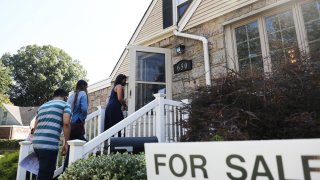
- Covid-induced demand from homebuyers over the summer caused an exceptionally strong spike in home prices.
- The 10-City Composite was up 6.2% year over year, up from 4.9% in the previous month. The 20-City Composite posted a 6.6% gain, up from 5.3% in the previous month.
Covid-induced demand from homebuyers over the summer caused an exceptionally strong spike in home prices.
Values jumped 7% annually in September, up from a 5.8% annual gain in August, according to the S&P CoreLogic Case-Shiller U.S. National Home Price NSA Index. That is the largest annual gain since September 2014. Prices are now nearly 23% higher than their last peak in 2006.
The 10-City Composite was up 6.2% year over year, up from 4.9% in the previous month. The 20-City Composite posted a 6.6% gain, up from 5.3% in the previous month. There was no reading for Detroit, due to data collection issues resulting from the pandemic.
This index is a three-month running average, so it represents prices from July through September, when buyers were eagerly seeking homes with more space for working and schooling at home due to the coronavirus.
"Housing prices were notably – I am tempted to say 'very' – strong in September," said Craig J. Lazzara, managing director and global head of index investment strategy at S&P Dow Jones Indices. "This month's increase may reflect a catch-up of COVID-depressed demand from earlier this year; it might also presage future strength, as COVID encourages potential buyers to move from urban apartments to suburban homes. The next several months' reports should help to shed light on this question."
Phoenix, Seattle and San Diego continued to see the highest annual gains among the 19 cities (excluding Detroit) in September. Home prices in Phoenix rose 11.4% year over year, followed by Seattle with a 10.1% increase and San Diego with a 9.5% increase.
Money Report
Dallas, Chicago and New York saw the smallest annual gains but were still up in the 4% range compared with September 2019.
All 19 cities reported higher price increases in the year ended September 2020 versus the year ended August 2020.
Low mortgage rates, which have set 13 new record lows this year, have helped fuel demand and prices. Rates are now down about a full percentage point from a year ago.
"The delayed spring homebuying season fueled sales well into October and past the time when they would normally begin to slow down," said George Ratiu, senior economist at realtor.com. "Heading into winter, demand continues to be strong, driven by mortgage rates which have broken record lows 13 times this year and a growing list of companies which have extended their remote work policies well into 2021."
Adding to pressure on home prices is the ever shrinking supply of homes for sale, already at a record low. Inventory fell to a 2.5-month supply at the end of October, according to the National Association of Realtors.
While single-family home construction is rising slowly, it is not even close to meeting the demand, especially in the lower price tiers. In addition, single-family building permits, which are an indicator of future construction, were basically flat in October month to month, according to the U.S. Census, suggesting construction is not going to rise significantly in the winter months.






